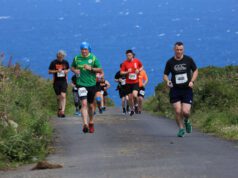By Seb Locteau edited and reviewed by Seán Bailey I have been reviewing this article recently, as it seems some website found it interesting. In what ever way people read, replicate or interpret it most coaches would agree on the basic principle of following a program.
how? by simply Training properly with quality.
Always question yourself, are my goals realistic? This is a 6:26 pace per mile after all! If your personal best is below 45min, with the correct program you can achieve a sub 40min. If your time is up around the 50 min mark, then maybe you should try to work towards a target of 45min. Of course at this stage you won’t break the 40min mark tomorrow, however if you give yourself plenty of time, say 16 weeks with a realistic date which you can work towards, set out your plan and endevour to stick to it, then you are well on the way to achieving your goal.






This plan will allow you some leeway, if you do happen to pick up an injury through training or even from over training, then it won’t be as mentally challenging.
For your first run – if you have more leg speed than strength pick a flat course, or if you feel strong in both leg speed and strength a course with hills might suit you best. Usually I would recommend the hardest sessions to be on the track and road where the intensity is determined by heart rate or pace. Heart rate and pace are dependant on the individual athlete, I personally believe in pacing because "heart rate" work sometimes stop’s athlete’s from pushing themselves through the limit zone which I call “the wall of perception”, which I will explain in greater detail in my next article.
By altering your route, and adapting your session to take into account changes in weather conditions and the different surfaces on which you are running it will prevent you from falling into the trap of becomming bored with "heart rate" or "interval" routine. As an athlete you want to be motivatedand have fun with sessions, constantly challenging your different energy system’s. Pace can vary depending on elevation and weather conditions, so don’t become disheartened when this happens to you, because it will at some stage. The track is great for testing and following up on intervals and heart rate zones, but can be very demanding on the body.









Don’t where to run ? use your imagination !
I always advise athletes to run in different weather conditions, whatever the weather you have to go and train, I believe this not only makes you physically stronger but mentally stronger also. You have no idea what the weather conditions are going to be on race day, so give yourself the best chance of performing to your best ability by not making the weather a determining factor in your training.
As a coach I need direct feedback from athletes such as their intervals on the road or trails, or at what their heart rates are and this will allow them to train without worrying about pace.
Again, coaching very athlete specific and one size does not fit all. the coach has to adapt his training to the athlete and not the other way around, God knows how wrong I was when I started coaching 13 years ago, you shouldn’t get too caught up with the pace you are running at or or focus too much on your heart rate. Every day is different, you feel different, your body reacts differently, your mood, what you eat, the weather etc.… In my plans or my athletes plans, I ask them to rate their sessions each time from 1 to 10, taking into consideration variables such as how they slept, the intensityof the session, their enjoyment of the session and their form that day. This gives a good indication on how best to plan the next session.
Sometimes you should let your disposition on the day determine how you train and not just stick rigidly to your plan. Listen to your body and enjoy some runs because you will have plenty of opportunities to punish yourself later, and who knows, you might even enjoy it. When I was training I always thought the harder I trained and the more often I did it, the better I would become. Today I believe the more you listen to your body, the better you will know when to work hard and when to relax.
I created a small schedule that you can try and if you do try it out I would welcome your feedback to see how you got on. Of course any coach can find some good and bad points, so I will put myself on the line to critics, but if you want develop this plan further then feel free to comment.
The rule I try to apply, is that if you miss one session, never try to catch up, let it go, don’t put yourself under pressure. On the other hand if you have some spare time you can do an extra session if it feel’s good to do "extra" I hope you understand the difference.
If you miss a session but have been running consistently over the past few months then you should be able to get right into the program. Consistency and recovery are the keys of success and I hope you will succeed in achieving that sub 40 min.
Finally, if you are prone to injury, visit a specialist such as Catherine McKiernan, her Chi-running technique helps a lot of runners every year. I recommend to my athletes to visit her before they get injured as a method of prevention rather than going for the cure afterwards, the same holds true with Physio, go before you are injured as preventative maintenance is less stressful on the body than treatment for injury. Vinny Mulvey is another running specialist which I would recommend.
Created July 2007 (S.Locteau), edited may 2009 (S.Locteau) & Reviewed 16/02/12 (S.Bailey)
Copyright © SEB Fitness 1999-2011 & Sports Ireland 2011-2012
Sub 40min 10km Training Program:
Always question yourself, are my goals realistic? This is a 6:26 pace per mile after all! If your personal best is below 45min, with the correct program you can achieve a sub 40min. If your time is up around the 50 min mark, then maybe you should try to work towards a target of 45min. Of course at this stage you won’t break the 40min mark tomorrow, however if you give yourself plenty of time, say 16 weeks with a realistic date which you can work towards, set out your plan and endevour to stick to it, then you are well on the way to achieving your goal.






This plan will allow you some leeway, if you do happen to pick up an injury through training or even from over training, then it won’t be as mentally challenging.
For your first run – if you have more leg speed than strength pick a flat course, or if you feel strong in both leg speed and strength a course with hills might suit you best. Usually I would recommend the hardest sessions to be on the track and road where the intensity is determined by heart rate or pace. Heart rate and pace are dependant on the individual athlete, I personally believe in pacing because "heart rate" work sometimes stop’s athlete’s from pushing themselves through the limit zone which I call “the wall of perception”, which I will explain in greater detail in my next article.
By altering your route, and adapting your session to take into account changes in weather conditions and the different surfaces on which you are running it will prevent you from falling into the trap of becomming bored with "heart rate" or "interval" routine. As an athlete you want to be motivatedand have fun with sessions, constantly challenging your different energy system’s. Pace can vary depending on elevation and weather conditions, so don’t become disheartened when this happens to you, because it will at some stage. The track is great for testing and following up on intervals and heart rate zones, but can be very demanding on the body.









Don’t where to run ? use your imagination !
I always advise athletes to run in different weather conditions, whatever the weather you have to go and train, I believe this not only makes you physically stronger but mentally stronger also. You have no idea what the weather conditions are going to be on race day, so give yourself the best chance of performing to your best ability by not making the weather a determining factor in your training.
As a coach I need direct feedback from athletes such as their intervals on the road or trails, or at what their heart rates are and this will allow them to train without worrying about pace.
Again, coaching very athlete specific and one size does not fit all. the coach has to adapt his training to the athlete and not the other way around, God knows how wrong I was when I started coaching 13 years ago, you shouldn’t get too caught up with the pace you are running at or or focus too much on your heart rate. Every day is different, you feel different, your body reacts differently, your mood, what you eat, the weather etc.… In my plans or my athletes plans, I ask them to rate their sessions each time from 1 to 10, taking into consideration variables such as how they slept, the intensityof the session, their enjoyment of the session and their form that day. This gives a good indication on how best to plan the next session.
Sometimes you should let your disposition on the day determine how you train and not just stick rigidly to your plan. Listen to your body and enjoy some runs because you will have plenty of opportunities to punish yourself later, and who knows, you might even enjoy it. When I was training I always thought the harder I trained and the more often I did it, the better I would become. Today I believe the more you listen to your body, the better you will know when to work hard and when to relax.
I created a small schedule that you can try and if you do try it out I would welcome your feedback to see how you got on. Of course any coach can find some good and bad points, so I will put myself on the line to critics, but if you want develop this plan further then feel free to comment.
The rule I try to apply, is that if you miss one session, never try to catch up, let it go, don’t put yourself under pressure. On the other hand if you have some spare time you can do an extra session if it feel’s good to do "extra" I hope you understand the difference.
If you miss a session but have been running consistently over the past few months then you should be able to get right into the program. Consistency and recovery are the keys of success and I hope you will succeed in achieving that sub 40 min.
Finally, if you are prone to injury, visit a specialist such as Catherine McKiernan, her Chi-running technique helps a lot of runners every year. I recommend to my athletes to visit her before they get injured as a method of prevention rather than going for the cure afterwards, the same holds true with Physio, go before you are injured as preventative maintenance is less stressful on the body than treatment for injury. Vinny Mulvey is another running specialist which I would recommend.
Created July 2007 (S.Locteau), edited may 2009 (S.Locteau) & Reviewed 16/02/12 (S.Bailey)
Copyright © SEB Fitness 1999-2011 & Sports Ireland 2011-2012
Sub 40min 10km Training Program:







The site http://www.runireland.com is amazing resource.
thanks
Good luck.
Hi, Just writing to point out a couple of inaccurate mile pace guidelines that you have written.
At the beginning of the article you say that sub 40 10k requires 6.13 miles. In the main article you say it requires sub 6.40 miles. Both these times are wrong. A 40 minute 10k is 6.26 per mile.
Interesting comment ! A friend of mine also email me from athenry AC.
for a 10km it is 6:26 and I correct the typo error, for 6mile it is 6min40, and for a 6.2mile it is 6min23
I think our calculation depends if you consider a 10km or a 6.2 mile or 6miles (10 kilometer = 6.213 711 922 4 mile)
Try this one : https://www.coolrunning.com/engine/4/4_1/96.shtml
but that’s a good comments thanks….. It means some of you read the article 🙂
I am so used to work in km. Thanks again
thanks for that. interesting.
Excellent! A sub 40 10k is my aim for 2009. I’ve run between 40:18 and 42:17 the last 2 years in a number of 10ks. I would just love to break the 40 min mark. I’ll let you know how I get on. Thanks!
Hi – just wondering what you mean when using the ‘pacing’ term in the notes eg ’45min pacing 4min15′. Thanks.
Pacing would be trying to keep the same time every mile or every km. Off course this can vary with the route.
So instead of going for the fastest mile when fresh and slowing down toward the end, you try to manage your pace all the way the same.